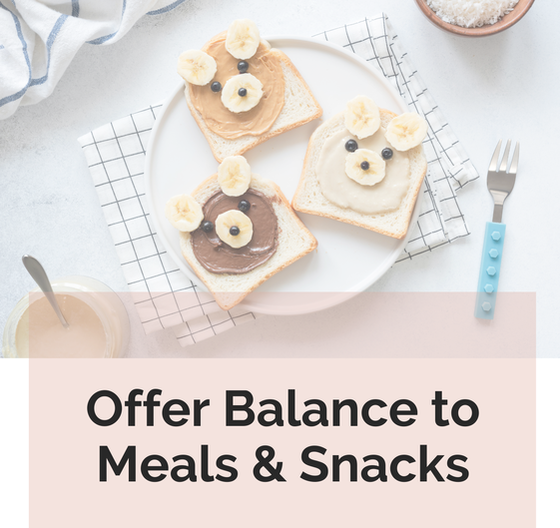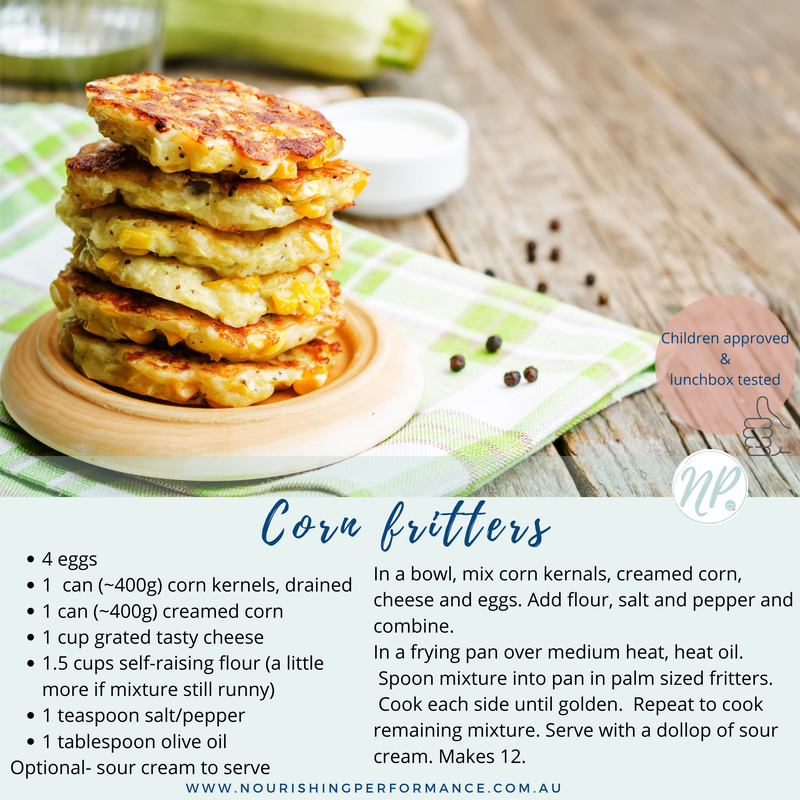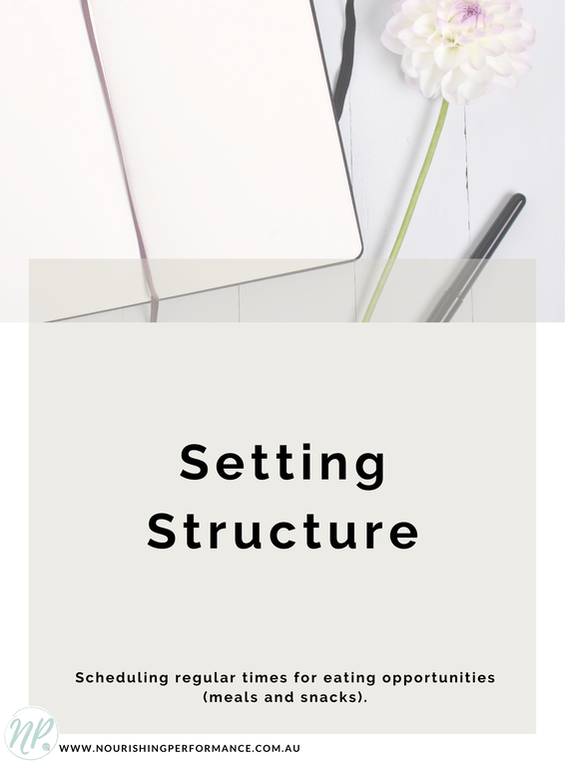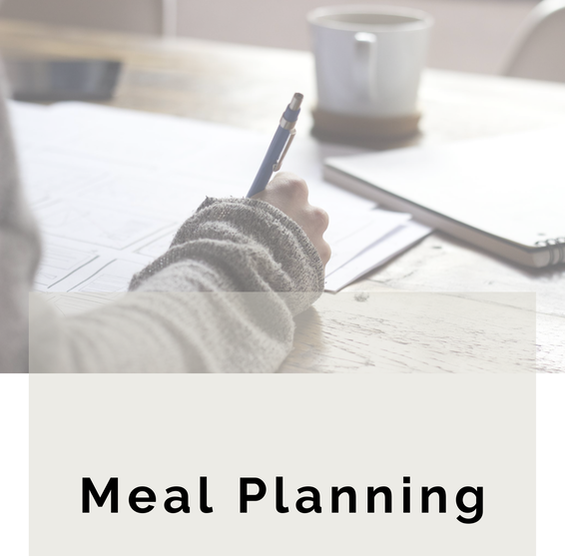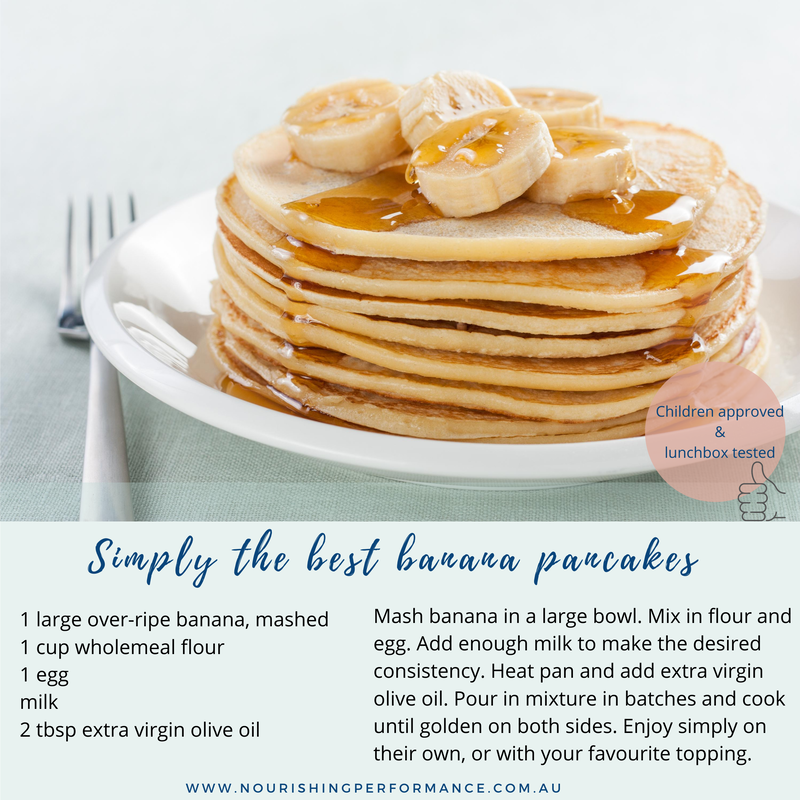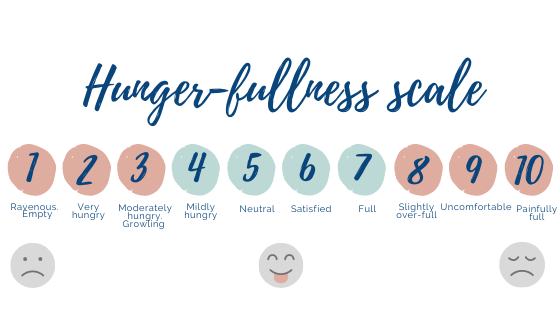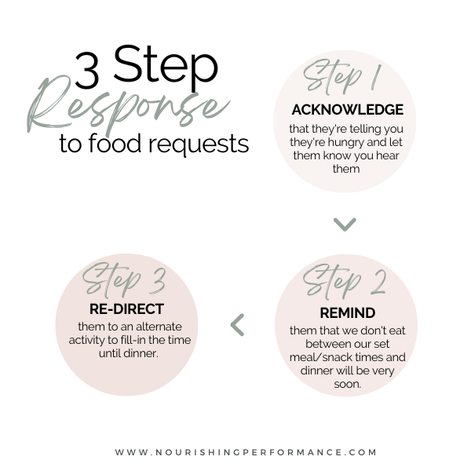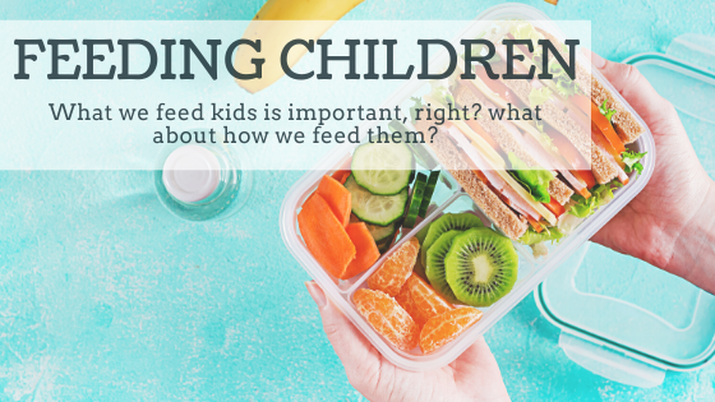|
Keeping things balanced is crucial to supporting wellbeing and kids learning to like new foods.. Offering kids nutritionally balanced meals and snacks is important for their general health, development and well-being. But, we know that right? It’s all too easy though, for parents to get caught in the rut of offering kids the same foods most of the time. Often the foods they know their kids will eat, foods they know their kids won’t refuse, and won’t kick up a fuss about being served. But, this doesn't necessarily serve kids well in the long run. Keeping the meals and snacks you offer kids balanced is more than just providing all of the food groups and a wide variety of nutrients to your child. Balanced meals and snacks for kids is also about offering a fine balance between foods your child knows, accepts, likes, and will eat and foods which your child not-yet-likes or foods you expect they will leave on their plate. Many parents would like more guidance on what foods make balanced nutrition…understandable. But, did you know that more parents feel they have a fair idea of what foods to serve their kids, but just don’t know how to go about getting their kids to eat these foods? Knowledge is only powerful if you have actionable steps for implementing this knowledge to make a difference. Knowing what nutritious foods to feed kids, is not powerful if you do not know how to support kids in eating a wide variety of these nutritious foods. Only 1/3 of parents are confident in the way they’re feeding their children. So, despite many parents having a fair idea of what foods their child should be eating, they are struggling with confidence in how to go about getting their kids to eat these foods. Having a solid strategy for how to plan what you will serve your children in order to optimise their eating patterns in the long run is one thing I teach parents in my FINISH FUSSY EATING online course. Knowing you are using a strategy which is best supporting your child’s eating patterns, and is backed by evidence and proven to work, can take a lot of stress, worry and parent-guilt away from you! It can not only improve the way your child eats, but give you invaluable confidence in the way you are feeding your child. --> What you can do now (other than sign up to the FINISH FUSSY EATING online course, of course...): 1. Offer your little ones nutritionally balanced meals and snacks each day
Offering your children balanced nutrition at each and every meal and snack is one very effective way to support improved eating behaviour in your child. A general rule of thumb is to offer 4-5 food groups at meals, and 2+ food groups at snacks.
2. Offer both, new or not-yet liked foods and liked foods at every meal and snack.
Offering your children a balance of new and already liked foods at most meals and snacks is one very effective way to support improved eating behaviour in your child. A general rule is to include 1 new or not-yet-liked food along with 1+ already accepted and liked ‘safe’ food (‘food friend’) at most meals and snacks.
So offering both, a balance of nutrition (food groups) and liked/not-yet-liked foods at each meal/snack, provides an opportunity for your child to eat a wide variety of nutrients, but also learn to like a wider variety of nutritious foods. If this all seems like a challenge to plan for and implement, then I strongly recommend you get on the wait-list for my FINISH FUSSY EATING online course. Alysha
0 Comments
Crazy Easy Corn Fritter Recipe Alysha Stevens
As parents we are always trying to find ways to get our little ones to eat more veggies aren't we?! It can feel like a constant battle. There is lots of ways (which I step parents through in my Nourishing Children-Coaching Package) that we can effectively support our kids in trying and learning to like a wider variety of nutritious foods...including veggies. One strategy is to continue serving them up and exposing kids to a good variety of foods. This includes serving up veggies in different and interesting (and delicious) ways! A pile of steamed vegetables on the side of the plate every, single, night wouldn't be appealing to kids who are still learning to appreciate and like foods, so you can understand why you would likely lose the battle of getting kids to eat them each night. A secret weapon you can use to win the battle (maybe not every time...but more often) is to have some simple, nutritious and delicious arsenal up your sleeve in the form of new vegetable recipes! These Corn Fritters are super simple and nutritious recipe you can easily whip-up for your kids and keep in your arsenal to help win the vegetable battles. They’re quick, easy and very versatile! 🥦 I often add in some grated broccoli, thinly sliced spring onion or green peas too! But, if your little one is a bit fussy, you can keep them quite plain (without green bits) at first, then when they’ve accepted and like the fritters (which may take a few exposures) you can add the new ingredient. It is always important to still expose your kids to some green veggies each day, so if they're not in the fritters, add them on the side....but then add into the fritters down the track. to mix things up. You could also use wholemeal flour in these if you wish or rice or any gluten-free alternative you wish! (I havn't experimented with every flour, so jiggle the amount around to find the best consistency). We love these as part of our dinner or lunch or even on their own as a snack!! And they’ve even been a hit in the kids’ lunchboxes (cold) too! I know families who like sour cream then smoked salmon on top! Some parents I've worked with have cooked them as a huge fritter and cut it up in slices like a pizza, some have done super small bite sized blobs...so go crazy with your creativity to keep it interesting for kids! Give them a go, get your kids helping and let me know if they approve! Alysha Structured meal and snack times for fussy eatersScheduling regular times for eating opportunities (meals and snacks) for your little one, usually after about 14-16 months of age, can make a world of difference when feeding a fussy eater. .Parents play a fundamental role in setting up the environment at children’s mealtimes which influence their early interactions, learning and experiences with food. Creating a positive mealtime environment goes a long way to setting children up with a good foundation of eating patterns, intuitive eating skills and a positive relationship with food, which sets them up to thrive both physically and mentally throughout childhood and into adulthood! Positive mealtimes, and therefore children’s eating patterns and behaviours cannot be optimised without a regular structure to their eating times. The Benefits of Having a Meal & Snack Time Structure for Children who are fussy.Creates predictability and securityThere has been a lot of research on children benefiting from routine. Routines create predictability and help children to feel secure in their day. Having a feeding schedule builds upon this daily structure. If children know what to expect when it comes to eating and when to expect meals and snacks they will feel more secure and relaxed about food which and in-turn improves their eating behaviours! Helps children connect wth hunger and fulness cues and reduces non-hungry eatingOne of your important roles when it comes to feeding your child, is deciding WHEN children eat. Without structured eating times, and when food is freely available between meals, children can learn to disconnect from feelings of true hunger and fullness and start saying ‘I'm hungry’ and want to eat when they are feeling bored, overwhelmed, when watching TV or doing homework etc. Eating can become associated with feelings and activities instead of hunger and enjoyment. Structure with eating helps children to learn how to effectively manage their hunger and self-regulate intake, develop self-control and avoid the dangers of mindless eating or eating in the absence of hunger. Allows children to develop a healthy appetiteA lack of structure with eating opportunities can also lead to children coming to the table with an appetite level not conducive for eating well. For children to be most willing to try new foods, or eat the amount that is right for them and build intuitive eating skills (ie eat when they're hungry and stop when they're full), they need to turn-up to the meal or snack with a healthy appetite. But without structure, they will often come to the table without much appetite at all as a result of snacking at the wrong times between meals. Or, you may also lose track of the time since kids have last eaten and run the risk of them becoming too hungry or ‘h-angry'! This increases the likelihood they will misbehave, be contrary, complain or whine about the food or have a meltdown as they will be less in control of their emotions. This almost never results in eating well or developing positive eating patterns. When too hungry, they are unlikely to try new foods, they may not eat at all (stress can diminish appetite) or they may overeat as they will be unable to easily notice and stop when they're feeling full. A healthy appetite at mealtimes will support their willingness to try new foods and help to prevent the associated negative behaviour and poor eating that comes with becoming too hungry. What to consider when setting structured eating times for your little onesThere are several important considerations to make when setting the times for your little-one’s eating times, the most important being your child's age. While babies and toddlers typically need to eat every 2-3 hours (5-6 times per day – 3 meals and 2-3 snacks), older kids do well with 3-4 hour gaps between meals and snacks (4-5 times per day- 3 meals and 2 snacks).
In order for consistency, it is also important to consider the eating times of school, kindergarten or childcare if your child attends. As the eating times at school etc is regular and not modifiable, it is recommended to continue with these times on the days your child is home also. An example : For a 7 year old attending school where eating times are 1100 & 1330, the home meal schedule could be: Breakfast-730am (for younger children, you may add in a snack around 930) Snack-1100 Lunch-1330 Snack-1600 Dinner 1815. Every child is very different, and there is no hard and fast rule for exactly how many eating occasions your child should have. So it's important to evaluate your own child and see what works best for you and for them. Consistency is key though. How to get started There are other important considerations to make, all of which I cover and guide my clients through making as part of my 1:1 Fussy Eating Support Program and online course. After setting your family’s meal and snack time structure, it is important to let your child know that there will be some changes and that there will not be any eating in between set meal and snack times from now on. Having a solid mealtime structure is a powerful strategy for improving eating behaviour, but sometimes it means you have to say no to food requests. You could have your family’s mealtime structure up somewhere within their sight such as on the fridge or in the pantry so that when they ask for food between meals, you can gently remind them when the next eating occasion will be, and show them your structured mealtimes up on the fridge. My '3-Step Response to Food Requests' is a responsive way to remind your children of the set mealtimes. Following these steps will help to maintain consistency and keep your feeding-style in-line with the most optimal Diplomatic feeding-style. Good luck with setting and being consistent with meal and snack times for your family. Alysha Success is the residue of planning - Benjamin Franklin Meal planning is asking "Whats for dinner" only once for the week (or fortnight) instead of every single day! It is simply planning what meals your family will be having for the week or two ahead. It is taking steps to be organised, prepared and time efficient in the kitchen. It is also having a ready answer for the imminent 5pm question from the kids of "What's for dinner?". But most importantly, meal planning takes away the mental load of deciding what to make for dinner every evening. How many times have you opened the fridge door and felt frustrated when considering what’s for dinner? Who gets tired of running out of ideas to cook every, single, night? How often have you gone to cook something only to realise you are missing one ingredient? Oh, and how often have you had to resort to a less nutritious quick option for dinner because you've ran out of time to cook and haven't prepared anything, cant be bothered thinking of something or you simply don't have anything in the fridge to cook? Do you ever wonder if you could take away some of the frustration and burden of preparing meals for your family? Well, by having it planned and all ingredients already purchased in a meal-planning-organised-shopping kind of way, your evenings will run much smoother and with much less stress! Having a plan for nutritious meals increases the likelihood of you including a wide variety of nutritious foods in your family's diet and reduces the reliance on convenience and take-away meals. If you have had a long and tiring day or have got home late from work and don't feel much like cooking, you are more likely to have the planned home cooked nutritious meal if you have planned for it and shopped for the ingredients and especially if you have already done some preparation for it. Do you ever wonder if you would eat more balanced meals over the week if you were a little more organised with meal planning? Chances are you would because research has shown that people who plan their meals are more likely to have a better dietary quality, higher adherence with nutritional guidelines and better food variety. Amidst our usual hectic schedules, meal planning is a great tool to help keep us on a healthy eating track, and what better time to start than while in Covid-19 lock-down!? One of the biggest advantages to meal planning is the time it saves busy families. With planned meals and organised shopping lists, there is no need for mid-week quick trips to the supermarket, or spending hours trying to decide what to cook for dinner each night! And hey, you can save even more time by cooking in batches, pre-preparing elements of the upcoming meals or re-using your meal plans! To do this, you need a plan! Here are my top 4 tips for being successful with meal planning. Plan the meals you will be cooking 1-2 weeks ahead
Be a smart shopper
Try themed nights
Have a Master Meals List
So with the benefits of meal planning for busy families...or anyone...it is very worthwhile giving it a go! If you would like some more individualised guidance with meal planning for your family, I would love to help, get in touch. Alysha 5 Tips for Feeding Fussy Eaters in the holidays 1. Have a planHaving a meal plan for the week will ensure each meal is nutritionally considered and will take the mental load off each afternoon when you don't have to think about what to make for dinner. Make a shopping list to make grocery shopping more efficient too. = easy 2. Have structured meal and snack timesSet times for meals and snacks and stick to them each day. By not letting kids go too long between eating or not grazing on foods all day long will mean they wont get 'hangry' and they will eat better at meals and snacks. = less stress for you! 3. Keep the balanceProvide nutritionally balanced meals and snacks and also provide meals that are balanced with foods your kids like and nutritious foods they not-yet-like. Expose them to new foods (while having the comfort of liked foods there too) and eventually they will love them! = woo hoo! 4. Get them involvedBy getting them to help with age-appropriate tasks in the kitchen will mean some quality time spent together, a learning opportunity f0r them and it significantly increases the likelihood they will eat the food provided without complaining! = win! 5. Keep a routineHave a routine for each meal and snack time such as: giving a 5 minute warning before eating time, washing hands, kids helping to set the table, sitting together to eat and tidying up together.
Simply the Best Banana Pancakes Who doesn't love a pancake?!
What parent doesn't love a super easy and nutritious pancake recipe to make their kids?! My kids are loving these at the moment during this Covid-19 lockdown 2.0. They love nagging for them, cracking the egg in (along with some shell), 'helping' me and making a mess mixing, they love pouring in too much milk that they are too thin to resemble pancakes, they seem to love fighting over licking the bowl, being impatient waiting for them to cook...but most of all they are loving topping them with maple syrup and gobbling them up!! Me too, to be honest! Oh, and the fluffy one loves lying beneath our feet, tripping us over while waiting for any drips to drop. We love adding in frozen blueberries (warmed up first) sometimes too. Enjoy x Are your kids constantly wanting to snack or graze on food?Is your child is asking for snacks allll daaay loooong? It may get tiring for us as parents, but is it the best thing to be saying ‘yes’ to our kids and allowing them to graze on foods allll day long? I often hear parents saying… "My kids are asking for food and they’ve just finished lunch 10 minutes ago!" "But if I just say ‘No’ they throw a tantrum, or are back nagging again in 10 minutes, and next minute they’re too hungry!" "Shouldn’t we let them eat when they’re hungry though?" "What if they didn’t eat much at lunchtime and need something else soon after?" "They’re saying they’re hungry allll day, but they don’t eat anything at dinner time." Your parenting instinct may be telling you to not allow the constant snacking, but it can be so damn hard not knowing how to best deal with the persistent nagging and most parents get worn down. The strategies we use to deal with these food requests and our overall approach to feeding our kids - our feeding-style – has a significant influence on how they will eat in general. Kids can request food for a multitude of reasons ranging from: actually being very hungry to boredom, stress or just the desire for a favourite food such as sweets. Children really thrive on routine and predictability and research shows it is really beneficial for children to have that predictability when it comes to eating times. I am a strong believer in having a meal and snack time structure where meals and snacks are given at the same times each day which provides regular and appropriately spaced out eating opportunities for children. Offering food at set times over the day allows your child to top-up at these eating opportunities and then develop a healthy appetite by the next snack/meal time without becoming too hungry. I find that often when kids are becoming too hungry between meals/snacks and demanding food, it is because something is out of whack with the set meal/snack time structure. We know that children will eat best when they have developed a healthy appetite. They will be less likely to refuse the nutritious food you have cooked and will be more willing to try new foods or the foods that are not-yet-liked. They will also be in good control of eating the amount that is right for them- they will be able to come to the table relaxed and eat enough and then also stop eating when they’re full, not over-full. On the hunger-fullness scale (below), ideally kids will arrive at the table for set meal/snack time at a #3-4- moderate to mildly hungry and finish eating at a #7-comfortably satisfied. If they are offered snacks within 1-2 hours of meal time and are topping-up their tummy, they will probably be between a #6 and #8 and with not too much desire to eat well when they arrive at the table for their meal. BUT, it is a fine line between having a healthy appetite and being….hangry!! No parent wants a hangry child! The hangry-monster is less able to regulate emotions and behaviour, will refuse to sit at the table, throw a tantrum because their dinner is on the wrong coloured plate or because the broccoli is touching the rice. They are unlikely to eat well while their emotions are not well controlled- they may be too emotional to eat more than a couple of mouthfuls and they most likely wont be open to trying new foods. Or they are so ravenous they may over-eat. This hangry-monster causes stress for the parents; stress about their behaviour and stress about the fact they didn’t eat well. So, we don’t want their tummy to be topped up before a meal, and we don’t want the hangry-monster coming to the table either. Now, you probably know this already, right? But the part that most parents find difficult is the HOW to get this balance right. HOW to hit that sweet spot. HOW to get their children to the table with a healthy appetite ready to eat the family meal with little fuss. Without keeping you reading here about how your overall feeding-style can improve your child’s eating behaviours for the next hour…because let’s face it, your child will probably be asking for a snack in that time…I will give you my 3-Step Response to Food Requests, to help manage the nagging for snacks and the grazing on food alllll day long so they can come to the table with a healthy appetite…and then eat well…which means less stress for them and you! 1. Acknowledge their request in a responsive way
2. Remind them of the firm meal and snack time structure
3. Redirect their attention
Example responses-
So, we want to prevent our little ones coming to the table with a tummy that is too topped-up to eat well or too hungry to have well-controlled emotions and eating behaviour. It is helpful to have a set and consistent structure for meal and snack times over the day. Our response to food requests and nagging for food between scheduled meal or snack times is important for preventing our kids eating snacks outside of the set times and ruining the development of their healthy appetite. The recommended 3-Steps for responding to these food requests is to acknowledge their feelings, remind them of the meal/snack time structure and re-direct them onto another activity. I have seen some great success following this structured response to kid's asking for food/snacks between structured meal and snack times. Give it a go, and good luck! But if the problem of constant nagging for food persists, I recommend re-evaluating your family’s meal/snack time structure (or introducing one!) and reaching out for some further guidance. For more guidance and many more strategies to improve your little ones eating patterns, join the waitlist for my FINISH FUSSY EATING online course! Alysha How parents feed their children, their ‘parental feeding-style’, or general attitudes and philosophies used to feed children influences the childs’ eating patterns and well-being both now and into adulthood. There is no doubt that what children eat is important for health, as a dietitian, supporting healthy eating is my passion and I understand the effects of a poor diet. We analyse nutrient intake and monitor physical health and growth, but often forgotten is the development of a healthy relationship with food and eating behaviour; two things which strongly influence the well-being of the child and future adult. Ideally, children will not only eat, but enjoy a wide variety of nutritious foods in a happy and relaxed manner (ie without experiencing pressure, guilt, shame or anxiety around eating). Developing this eating behaviour in children will track into adulthood and set them up for good health. Additionally, for optimising well-being children will be supported to eat intuitively, eat when they are hungry and stop eating when they are full. This will set them up with more body trust, a positive relationship with food and prevent their need to rely on external measures of regulating food intake such as dieting (which can have severe negative effects on overall well-being- a story for another article!). Fostering the development of these is the tricky part and largely comes down to how they are fed and their experiences at mealtimes. Parents are not only responsible for what foods are available and offered to children, but also for the mealtime environment and the nature of the child's early interactions and experiences with food. This shapes eating patterns, emotions and attitudes around food which last years, decades, or even a lifetime ahead. Most parents are in pursuit of ‘perfect nutrition’ for their child and while they have a fair idea of ‘what’ foods make balanced nutrition and ‘what’ they are striving for their children to eat, they’re often getting lost in the ‘how’ to achieve this, or ‘how’ to go about feeding their little ones . How to encourage them to be adventurous and confident with eating new foods. How to encourage them to enjoy a wider variety of vegetables, or even how to get them to eat a single vegetable sometimes! How to reduce fussiness. How to encourage a broad and healthy palate without compromising their relationship with food or eating attitudes and behaviours. The impact of 'how' parents go about trying to achieve this, their ‘parental feeding-style, is often not considered. How we feed kids, or our style of feeding them and their mealtime experiences can affect the development of eating behaviour which strongly influences not only long term eating patterns and variety of foods enjoyed, but also body trust, body image and risk of obesity, mental health concerns and disordered eating. Parental feeding style is crucial. Feeding children is thankless and challenging. The worry and stress parents have at mealtimes impacts the way they feed their children, or their feeding style. Parents are often concerned their kids don’t like vegetables and don’t eat enough of them so they force them to sit at the table until they’ve eaten all veggies on their plate. They’re worried their kids aren’t having enough calcium, so they force them to eat yoghurt or cheese whether they like it or not. There is also a lot of bribery taking place at the dinner table, “eat your vegetables and you can have dessert” I also see a lot of parents not wanting to say “no” to their children. They’re cooking several different meals per night to suit the child’s ‘likes’ in order to avoid tantrums or complaints about the meal. Or, providing only a limited variety of meals/foods which caters to the child’s ‘liked’ foods. Parents are also busy, and are often just trying to survive, so are avoiding resistance from kids at mealtimes. They’re anxious about whether their child is eating too much or not enough, and are often self-admitted “control freaks” when it comes to how much their children are eating. Parents are doing their best. The 4 parental feeding-stylesFeeding style strongly influences the interaction between parent and child around food and at mealtimes and consequently the development of childrens’ eating behaviour and relationship with food. There are four recognised feeding styles, of which parents usually use one most of the time and then sometimes mingle it with another. Uninvolved (neglectful) style- Parents with this style tend not to place much importance on food and eating or on the importance of healthy nutrition for themselves or their children. There is typically not much planning or preparation for meals, pantries and fridges are often quite empty and/or lacking in a variety of nutritious foods. This can leave children feeling insecure about when and what food they will eat and can become overly focused on food but with limited exposure and acceptance of a variety of nutritious foods. Indulgent (permissive) style- Parents which have this more lax feeding-style say ‘yes’ a lot, they indulge their children’s every food wish and with not many rules and boundaries around food. The parent may initially say ‘no’ to the treat or particular food requests, but can be easily persuaded by the nagging child who eventually hears “well okay, yes I will cook that for you.” The children will often hear things like “sure, you want cookies, no problem”. These parents will cater to the child's preferences and meal requests and tip-toe around the foods the child doesn’t like to prevent refusal to eat the meal. Children experiencing this style often don’t have food boundaries or structured meal and snack times, they can help themselves to whatever food they want and therefore, find it difficult to regulate their intake of unhealthy foods, and are not encouraged to try and accept a wide variety of nutritious foods. Using a ‘reward’ approach is very common with this style of feeding, though I think most parents use it from time to time. This is when there is a food reward attached to something such as “if you eat your peas, you can have dessert”, or “if you are well-behaved, you can have a lollipop”. This ‘rewarding’ approach, while fun for the kids, changes their heirachy of food preferences. Research shows that children learn that the reward foods are more valued and they build a strong preference for those foods and the healthier target food, the peas, are less desirable and may seem like a punishment or a chore to eat. Controlling (authoritarian) style- This approach is based on what the parent thinks is best, with little/no consideration for the child's preferences. This is the "you cannot leave the table until you’ve finished everything on your plate" style. The parent can be very focused on the nutrition quality of the child’s diet and controls not only what, but also how much they believe the child should eat. Commonly, the parent believes they know exactly how much the child needs to eat at every meal and ignores the child’s preferences and natural appetite which fluctuates with growth patterns, daily activities etc. While the child may eat their veggies most days (because they’re forced to), the child may not be supported to enjoy the food and is less likely to eat a varied diet later in life. Also, the child loses their innate ability to self-regulate their appetite and eat according to their hunger and fullness. They are taught that how they feel is not important, but eating the amount they’re told to, is. Weight problems, both overweight and underweight, typically arise in children experiencing this feeding style. Diplomatic (authoritative) style- This feeding style is the most balanced approach for developing desired eating habits, or the best at getting kids to eat healthily, both now and in the future. Much research has shown it to be associated with the most positive health outcomes for the child. It encourages the child’s independent thinking and eating regulation while setting boundaries at the same time. It recognises that parents play a role (they decide what will be served, when and where), and respects the fact that the child also has a role to play (deciding how much they will eat from what is offered). Though there is structure and boundaries, the child’s feelings and preferences are considered and there is no pressure involved for the child to eat more or less. There is trust in the child’s ability to recognise hunger and fullness signals and then eat the amount of food to satisfy those cues which forms the basis of this feeding style. Maintaining control of what is offered, or the options available for the child, the parent may ask “which fruit would you like in your lunchbox today, apple or pear?” or may put several vegetables out on the dinner table for the child to choose how much of each they eat (without pressure). This empowers the child's autonomy and confidence in making healthy decisions. Research shows children experiencing this feeding style are more compliant, calm, happy and less anxious around food and mealtimes, are a more healthy weight, can make better food choices on their own, are more accepting of new foods and eat a wider variety of nutritious foods when compared to children experiencing other parental feeding styles. When nutritious foods are offered regularly and the pressure is taken away (ie no forcing or bribing to eat everything on the plate), kids become more relaxed and adventurous with food and develop a better relationship with food. Research shows that these children are a more healthy weight, can make better food choices on their own and eat a wider variety of nutritious foods when compared to children experiencing other parental feeding-styles. Parents who approach feeding kids this way have fewer struggles with healthy eating in their kids! How can you optimise your feeding style?The division of responsibility, developed by Ellyn Satter and based on the research in feeding practice provides guidance and a structure for parents to optimise their feeding style. The division of responsibility encourages parents to make the boundaries for and decide the what, when, and where of feeding and then trust and support the child in deciding how much to eat from what is provided. This approach takes the pressure off children, removes the anxiety around mealtimes and supports the development of intuitive eating and childrens’ autonomy around healthy food choices. It supports the development of a healthy eating behaviour and positive relationship with food. While this approach takes some learning and practice and is best achieved when followed full-heartedly, it is well worth it! It is less stressful and more beneficial for both children and parents! Consulting with an accredited dietitian for individualised advice and strategies to support you working towards this diplomatic (authoritative) feeding style using the division of responsibility would be valuable. In the meantime, to be helpful without harming your child’s eating behaviours: You decide what food is available and offered, and trust your child to decide how much they eat from what is provided. It is recommended that parents decide ‘what’ foods to offer children. Be considerate of your child’s lack of food experience without catering specifically to their likes and dislikes. Resist giving in too much to the food requests of little ones, though some compromise may be a great idea. For example, if there is nagging for macaroni-and-cheese, offer it only sometimes and as a side to the rest of the family meal. This exposes them to and encourages them to explore foods they may not have yet accepted while having a comfortable food available also. Offer a variety of nutritious foods that you/your family enjoy eating, and trust that your child will learn to enjoy those foods also. Offer several different vegetables where possible, ideally some which are accepted and liked and some which are not yet accepted, and allow children to choose which ones they eat and how much they eat. If food textures is an issue for your child, offer foods with a variety of textures at the same meal for them to explore and choose from. As tempting as it is (verrrry tempting!), avoid pressuring or bribing children to eat more (or less) of certain foods offered. Don’t be too worried if they don’t eat much of the veggies (easier said than done), remember that pressuring or bribing will do more harm in the long term and with regular exposure of these veggies in a relaxed no-pressure environment, kids will learn to accept and like new foods. Seeing parents eat the same foods they are offered also increases the likelihood of the child trying and liking the food. Be patient. So, there is no doubt that children need to eat healthy foods, but the way in which parents go about encouraging these eating patterns is important. I understand the importance of meeting adequate nutrient intake for health, but through my training and practice as a dietitian (and parent of 3 little ones) I have learned a lot about feeding dynamics, the impact of feeding styles, and the value of fostering intuitive eating. Forcing, bribing or tricking children to eat well is stressful and doesn’t work, in fact it does harm. In the pursuit of providing short-term ‘perfect nutrition’ for your child, the impacts this may have on your feeding style can be detrimental to your child’s eating behaviour in the short-term and long-term. There is plenty you can do to optimise your style of feeding or the ‘how’ you feed children, therefore setting your child up for a healthy eating behaviour and relationship with food whereby they eat (and enjoy) a wider variety of nutritious foods in amounts that are right for their body, in a relaxed and happy manner! Happy eating! IS BODY-SHAMING A REAL CONTRIBUTOR TO UNHEALTHY, MORE THAN FAT ITSELF?
There is racism, sexism….and then there is weightism. Also known as weight-stigma, weight-bias, body-shaming or fat-shaming, this is the discrimination or stereotyping based on someone’s weight or body size. Our culture fosters prejudice against body weights and sizes and this is becoming a bigger problem. Why do we still think it’s okay to ‘put down’ the over or under weight or treat someone differently because of their physical appearance? Furthermore, is stigmatising someone’s weight going to motivate them to be any healthier? Do we justify it by the ‘link’ overweight has with health issues? The wise J.K. Rowling once said ~ “Is ‘fat’ really the worst thing a human being can be? Is ‘fat’ worse than ‘vindictive’, ‘jealous’, ‘shallow’, ‘vain’, ‘boring’ or ‘cruel’? Not to me” ~ Weight stigma is pervasive. It occurs in workplaces, schools, on trains, in doctor’s offices, even at home. It happens behind peoples backs and also to their faces. It happens with vindictive and cruel connotations even sometimes with no harm intended. However, it always results in harm done. “She’s too skinny, she needs to eat more” “She’d be pretty if she was thinner” “What a fatty. I bet he’s lazy.” “Oh you look great, you’ve lost weight” (this is well intended, but insulting none the less. It suggests they didn’t look great before they lost weight, and also suggests thinner is better) “You’ve put on a little bit of weight around your middle. Best if you lose that so you don’t have a heart attack” (the complex manifestations of this comment may have just increased the person’s risk of a heart attack more than being at a higher weight) “You might feel better if you lose a few kgs” (they might feel better if you don’t comment on their weight!) “You need to start watching your weight if you want to find a partner” “You are too fat to adopt a baby” or “too fat for IVF treatment” “She has fatty arms” “I heard this 5:2 diet is good for losing weight, you should try it” We have a cultural obsession with the scrutiny of others and for some reason, this fat-phobia and this discrimination is considered okay in our distorted society. As Jennifer Anniston recently said “I’m fed up with the sport-like scrutiny and body shaming that occurs every day” “it reflects the warped way we calculate a women’s worth”. The constant messages and suggestions that people are undesirable and less worthy in a bigger body, is damaging. The fat jokes are often intended as harmless fun, and the larger people ridiculed for eating a burger is not even blinked at, but it’s damaging. The unsolicited, well intended diet advice given to those who are supposedly not good enough just as they are, is damaging. I believe shaming someone’s weight, size or appearance is a judgment which says a lot more about the person making the comment than it does about the person on the receiving end. “What Susan says of Sally, says more of Susan, than of Sally.” Is the vilification of fatness justified by the supposed link with disease and early mortality? Not at all. You cannot shame someone into losing weight or becoming healthier. It does not work. Full stop. There is a rapidly growing body of research which shows the detrimental effects it has on someone’s physical and mental health. (1) Thin shaming can be as equally hurtful and detrimental to someone’s health as fat shaming. Any form of body shaming is mean and needs to stop. WE HAVE A FEAR OF FAT We are bombarded with anti-obesity talk, warnings that fat is bad and misinformed messages that weight loss is the answer to this ‘problem’ and will always lead to improved health. These tales which perpetuate the thin ideal have spread so far and are so embedded in our culture and our psyches that we are blind to what really constitutes health. It has led to a fear of fat and a hateful bias towards fat people. The ‘obesity epidemic’ talk suggests that obesity is a direct cause of diseases and people dying prematurely. This stems from the knowledge that there is an association between being over-weight and many diseases….but this is not necessarily a causal relationship in which one causes the other. As an example: We know more firemen sent to a fire is associated with more damage done. So, do we say more firemen cause more damage, or could there be another factor causing both? Yes, the factor of a more ferocious fire increases the damage done at the same time as increasing the need for more firefighters. So, we know that being overweight is associated with chronic disease, but we don’t know that being overweight is the sole cause of disease. It is likely other factors such as fitness, activity, diet and socio-economic status increase disease risk at the same time as increasing the risk of weight gain. Fat itself probably doesn’t cause disease, behaviours that can lead to overweight can also lead to the associated diseases. WHAT ABOUT THE OBESITY PARADOX? There is a pattern of overweight and obesity being associated with longer survival in many diseases. Obese people with diabetes, hypertension, heart disease or chronic kidney disease actually live longer than thinner people with the same condition. (2) Body size, except for absolute extremes, does not strongly predict longevity. In fact, it has been shown that overweight people live as long as or even longer than ‘normal’ weight people. In other words, weight itself is not an accurate predictor of living longer or dying from disease! (2) Evidence shows the idea ‘fat is bad’ is archaic. (2) The old argument of fat is bad for one’s health no longer justifies any weight stigmatising or fat-phobic rubbish. There is definitely a problem with people eating unhealthily and moving too little which can increase risks of many chronic diseases, however this applies to all body types. A healthy diet and regular exercise can influence a person’s health more than their level of ‘fatness’. Overweight, but cardiovascular fit individuals have a lower risk of mortality (dying) compared to normal-weight, unfit individuals. (3) A growing body of research suggests most indicators of health can be improved by changing health behaviours, regardless of whether weight is lost or body shape changes. For example, behaviours such as diet and exercise can reduce blood pressure and blood lipids and improve insulin sensitivity even if there is no change in body weight. (2) Body size is NOT an accurate indication of health. Health is much more complex than that. It encompasses many physiological factors, emotional state and social connection. All of which cannot be measured simply by looking at someone, and all of which are influenced by many, many factors! Health should not be oversimplified and portrayed to be about only physical appearance or fatness. People can have a small body, a medium body, even a large body and still be healthy. Being ‘overweight’ does not equal unhealthy. Being thin most definitely does not automatically equate to optimal health! No one is qualified to be able to simply look at someone and know their risk of disease! Next time you’re about to judge someone’s health based on their weight, think again. Health comes in all sizes! Our focus should be off weight and on the promotion of healthy behaviours regardless of the amount of body fat somebody has. And let’s be honest here, if someone is happy to be of a bigger size, even if they’re unhealthy, and don’t want to pursue healthier behaviours, then who are we to judge and criticise. Their body, their business! WEIGHT STIGMA ITSELF DAMAGES HEALTH The fear of fat and the pursuit of weight loss has not made the population thinner or healthier. Our cultures obsession with thinness, the associated weight stigma, and constant suggestions for people to lose weight leads to feelings of shame and body hate and doesn’t do any good. Weight shaming does not encourage people, but demotivates behaviour changes to improve health. It disheartens people, it disempowers them and most definitely does not support them. It is paralytic. It’s causing more harm than good. These people are less likely to respect and care for their body and take steps to improve their health which leads to a long, downward spiral of physical, mental and social implications; poor body image, low self-esteem, stress, anxiety, depression, weight cycling/fluctuations, dieting, binge eating, less physical activity and avoiding medical care. Additionally, each of these also have their own health consequences and ultimately leads to poorer health. People’s wellbeing is compromised and they suffer these side effects as a result of feeling pressured to conform to the unrealistic and unjustified body ‘ideal’. It causes stress The stress of social stigma causes the chronic release of stress hormones which can initiate or aggravate conditions such as heart disease, high blood pressure and cholesterol, diabetes, stroke, anxiety and depression. (4-5) These physiological effects of stress, rather than ‘fatness’, may be part of the explanation for overweight people experiencing these health issues. The overproduction of these stress hormones can also lead to over eating and increased weight gain, perpetuating a viscous cycle. It leads to disordered eating and dieting Discrimination and the pressure to lose weight often leads to dieting and disordered eating. This can include binge eating, skipping meals, self-induced vomiting, obsessive calorie counting, poor self-worth, misuse of laxatives and diuretics, fasting or chronic restrictive eating. These abnormal eating behaviours lead to fatigue, malnutrition/nutrient deficiencies, poor concentration, affected social life and anxiety and depression. (6) Dieting is the biggest risk factor for developing an eating disorder. Girls who diet are 5-18 times more likely to develop an eating disorder compared to those who do not diet. (6) for more information regarding eating disorders and how to help someone, visit The Butterfly Foundation. Unfortunately, diets do not work. If they did, would we still have this so called ‘obesity crisis’? Has dieting contributed to the increased prevalence of overweight? It is very well established that only a very small percentage of dieters maintain their weight loss for more than a couple of years. Weight is often regained even if dieting and exercise is continued, and most regain more weight than they lost! This leads to further restriction/dieting and consequently further weight gain. There are biological systems humans have which resist long-term weight loss. (The physiological, psychological and emotional reasons diets don’t work, and the associated health implications is a very significant and complex issue which I will unravel in a future post). This weight-cycling, losing and regaining weight, has been shown to cause increased risk of some of the very health conditions we associate with obesity; heart disease and diabetes. In many cases being overweight but a stable weight is more healthy than losing and regaining weight. (2) It fuels body dissatisfaction People are hating their bodies more and more and at younger and younger ages. It dampens motivation for physical activity It is well established that weight shaming demotivates people to engage in healthy behaviours. If you want to make someone less active, just call them a derogatory, fat bias name, or simply tell them their body isn’t good enough and that they need to lose weight. That will probably do the trick! Some research has shown that a lot of people who perceive weight discrimination or stigma are more likely to avoid physical activity and this is true whether the person is overweight or not. (7) It may even contribute to the cycle of weight gain and further stigma. It leads to avoiding medical care Patients in bigger bodies often experience prejudice, derogatory comments and poor treatment when visiting a doctor. Often the finger is wagged at them and they are told to lose weight even when the reason for visiting is 100% unrelated. “Doctor, I have a sore throat” “Well, you really need to lose weight”. “Doctor I slipped and broke my arm” “Okay then, you need to get this weight under control” “Doctor, I’m on fire!” “Hmm we really should do something about this excess weight, that will make you feel better”. No research has shown that losing weight improves health in the long term, mainly due to the fact it is rare for people to maintain the weight loss for more than a few years. Furthermore, there is collateral damage that comes with the pursuit of weight loss; there are many unhealthy consequences. So, these ‘weight loss’ focussed recommendations are not evidence based at best and unethical at worst. Remember, healthy behaviours do improve someone’s health regardless of weight changes! Patients who are made to feel ashamed of their body, no matter what size they actually are, are more likely to miss general check-ups and health screens which of course has poorer outcomes. Every person in every body size and shape deserves the same respect, compassion and equal opportunities to health and a happy life. Some researchers have suggested that the consequences of a person experiencing weight bias may be more harmful to them than simply having a large body and that perhaps the health problems we see in bigger people may be largely the result of weight bias and discrimination. (8) Furthermore, people of ‘normal-weight’ can also be sent in this downward health spiral when they feel the pressure to be thin and adopt restrictive dieting behaviours. Researchers have concluded that due to the significant social, psychological and physiological consequences of being victim of weight stigma, it in itself is a public health concern. (9) WHAT WE CAN DO As a dietitian I help guide clients in the direction of eating well and support them in making behaviour changes which will help to optimise all facets of health, and I will measure their success in much more meaningful ways than a number on the scales. My instinct is to be compassionate first and my professional expectation is to do no harm. ‘Follow your instincts. That’s where true wisdom manifests itself.” Oprah Winfrey Weight stigma does harm. Diets do harm. On the contrary, encouraging respect for bodies, no matter the amount of space they take up in the world, leads to more healthful nourishment and exercise along with other self-care behaviours and ultimately, happier and healthier people! Compassion does no harm. My beautiful Nan always said to me “If you cannot say anything nice, then don’t say anything at all”. Very wise words, and it proves to be a very good idea in this case of body size. So, If you can’t be kind, be quiet. Let’s accept and respect all body shapes and sizes and minimise the unintended consequences of weight stigma. After all, there is no wrong way to have a body! Let’s take the emphasis off our obsession with thinness and weight loss and encourage healthy behaviours, well-being and happiness for all people regardless of body size. Let’s focus on what is really important. Oh, and let’s be compassionate. Ponder this for a while. Think about it as you go on with your everyday lives in this weight obsessed world. Be mindful when you find yourself judging. Pull yourself up and be quiet if you find yourself shaming or suggesting weight loss. Remember it when you see or hear someone else criticising someone, simply because of their body size. Remember the harm it does. Alysha
We should all aim to eat a rainbow every day (and no, I’m not talking about skittles and m&ms!). A variety of colourful fruit and vegetables will bring us a rainbow of colour and nutrients. To optimise health and help prevent chronic disease, we need to eat 5 serves of veggies and 2 fruits every day!
Each fruit and vegetable’s vibrant colour, taste and aroma is caused by specific phytochemicals produced by the plant to help protect the plant from things such as insect attack or the sun's UV radiation. Although phytonutrients are not essential for us to survive (un-like vitamins, minerals, protein etc), they do provide significant benefits for humans who eat these plant foods. All colourful fruits and vegetables have these nutrient powerhouses, as do legumes, nuts, tea, wholegrains and many spices. Each colour brings the food it’s own distinctive variety of vitamins, minerals, antioxidants and phytonutrients our body needs to thrive. Diets full of a variety of phytonutrient-rich plant foods have shown to be effective at reducing the risk of heart disease, diabetes, and certain types of cancers and promoting longevity. There are more than 25,000 phytonutrients (and i'm sure many which are yet to be found), of which some groups are of particular interest. It is easy to fall into the habit of buying, cooking and eating the same limited variety of fruits and vegetable that you and your family like, but eating enough plant foods is important, and a wide variety is the key as most people fall short in most colour categories of phytonutrients. RED fruits and vegetables contain phytochemicals, including lycopene, anthocyanins and ellagic acid which have been studied and linked with reducing the risk of diabetes, heart disease and stroke, age-related vision impairment, preventing certain cancers. Lycopene in particular, found in highest concentrations in watermelon and cooked tomatoes, is known to help prevent prostate cancer. Ellagic acid, in raspberries, strawberries, blackberries, cranberries, grapes, pomegranates and even walnuts, is also a potent antioxidant associated with anti-cancer activity, may also help to reduce blood pressure and build-up of plaque in the arteries and slow glucose absorption in the gut.
ORANGE AND YELLOW foods are full of carotenoids such as beta-caotene, beta-cryptoxanthin and lutein which are also strong antioxidant and anti-inflammatory phytonutrients. These foods have been associated with improving immune function, preventing various cancers and heart disease, promoting healthy joints, skin and eye health and vision (yes, it is true that carrots can help with your eye-sight!).
GREEN fruits and vegetables are rich in phytonutrients and chlorophyll which is loaded with antioxidants that promote well-being. Green fruits and vegetables are one of healthiest foods we can eat and are rich in lutein, zeaxanthin, isoflavones and many other phytonutrients. Green plants have been linked with reducing risk of several cancers, blood vessel damage, heart disease, boosting the immune system and energy levels. The consumption of flavonoids, of which some are in green plant foods, is significantly associated with longevity.
BLUE AND PURPLE fruits and vegetables are rich in the phytonutrients anthocyanins and resveratrol, and have been studied extensively for their anti-cancer, anti-inflammatory and anti-aging properties. These work to repair damage from oxidative stress and inflammation and reduce the risk of cancer, stroke and heart disease. Reversatrol may also protect brain function and slow cognitive decline and is being studied as a possible treatment for type-2 diabetes.. Large concentrations of reversatrol are found in red wine which may explain the health benefits associated with red wine consumption. The skin of grapes are also a great source as well as grape juice, blueberries and cranberries and even peanuts and cocoa.
I need to clarify here that these phytonutrients in their whole-food form (ie eating them in a real food) have shown to be beneficial, however taking these in supplement form has not shown the same benefit and isn’t recommended as they may increase the risk of some health complications. The only way to increase the intake of phytonutrients is to eat more plant foods and include a varied array of colours to reap all of their benefits! Try cooking with a wider range of vegetables, add more into the foods you regularly eat and try new recipes and develop an appreciation for new foods. Of course, eating a rainbow is harder for kids who are still learning to like veggies! Always expose children to as many different nutritious foods as possible. Don’t give up if they refuse the new vegetable the first, second, third or even fourth time theyre offered it. It can take around 20 times of being exposed to a new food before children learn to accept it. They may start by flicking it off the plate, then being okay with it there, then poking or picking it up, then licking it or tasting and spitting it out. Eventually, with repeated exposure and no pressure to eat it, they will learn to accept it – especially if they see other family members/parents eating it! Other types of exposure to vegetables will also help kids be more curious about them, reduce anxiety around eating them and make them more likely to try them, accept and even like them! Reading about them, looking at and talking about them in the supermarket, helping to grow, prepare and cook them, and especially seeing them on the plate every day helps. Even colouring them in may help, so download the ‘Eat a Vegetable Rainbow’ colouring page here and lettuce see your little one’s best colouring! There will be winners announced in March 2020, but feel free to colour the page anytime! Alysha |
